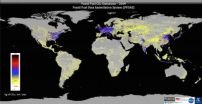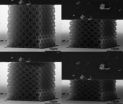(Press-News.org) Researchers led by Dr. Helen McNeill at the Lunenfeld-Tanenbaum Research Institute have revealed an exciting and unusual biochemical connection. Their discovery has implications for diseases linked to mitochondria, which are the primary sources of energy production within our cells.
Dr. McNeill's team has an international reputation for their work in understanding how cells become organized into tissues and how growth is regulated during development. The group focuses on mutations in the fat (ft) gene. The protein product of this gene, called 'Fat', acts at the cell membrane to promote adhesion and communication between cells. Mutations in ft can cause cells to overgrow and become tumours. This occurs partially through the Hippo pathway, a pathway that is frequently activated in cancers such as liver, breast, ovarian and sarcomas.
Fat proteins are typically thought to work at the cell surface, but the team's paper, published today in the prestigious journal Cell, uncovers for the first time that a piece of the Fat protein is actually processed and delivered into the mitochondria where it influences the energy status of the cell. Importantly, when this particular component is missing, the energy generating pipeline inside mitochondria become destabilized, leading to loss of energy production.
"We were amazed to find that Fat proteins interact directly with mitochondria in a cell, regulating the cell's metabolism" says Dr. McNeill, a Senior Investigator at the Lunenfeld-Tanenbaum Research Institute and a Professor in the Department of Molecular Genetics at the University of Toronto. "We still want to know how a cell knows when to release the Fat protein into mitochondria, but for now, this new linkage opens up a whole new way of thinking about how cellular energy is controlled as well as new ideas about how to shut down cancer cell growth."
When mitochondria stop working properly, cells no longer have an efficient energy source. Instead, cells will switch to glycolysis to produce the energy they require, known as the Warburg effect. Similarly, tumour cells have glycolytic rates up to 200 times higher compared to normal cells. Since the mitochondria is responsible for producing energy for essential cellular functions, problems with mitochondria can also lead to illnesses such as Type 2 diabetes, Parkinson's disease, heart disease, stroke, and Alzheimer's disease.
The research team has been evaluating their unique discovery in fruit flies, since they serve as a powerful model for human mitochondria. Their next steps are to test these findings on human cells.
"This new finding that links the cell membrane to mitochondrial function is important since it defines a totally new mechanism of cellular regulation," says Yonit Tsatskis, a Research Associate in Dr. McNeill's lab.
Her co-author Anson Sing adds, "When I started this project I had expected to learn a bit about eye development in fruit flies, but I had no idea that it would lead me to work on mitochondrial and metabolic defects in tumour cells. That's what's great about working in research, making new discoveries and connections. It's exciting to be a part of that scientific process." Sing is a Ph.D. candidate in Dr. McNeill's lab.
Dr. McNeill and her research team are investigating the specific role the ft gene plays with the hope of identifying new treatment targets for cancer and other diseases related to Fat malfunction.
INFORMATION:
The study is "The Atypical Cadherin Fat Directly Regulates Mitochondrial Function and Metabolic State," published in Cell on September 11, 2014. The authors are Anson Sing, Yonit Tsatskis, Lacramioara Fabian, Ian Hester, Robyn Rosenfeld, Mauro Serricchio, Norman Yau, Maı¨lis Bietenhader, Riya Shanbhag, Andrea Jurisicova, Julie A. Brill, G. Angus McQuibban, and Helen McNeill. The study was funded by the Canadian Institutes of Health Research.
Researchers make scientific history with new cellular connection
2014-09-11
ELSE PRESS RELEASES FROM THIS DATE:
Primary care doctors reluctant to provide genetics assessment in routine care
2014-09-11
Ann Arbor, Mich. — Primary care providers report many challenges to integrating genetics services into routine primary care, according to research published today in Genetics in Medicine.
Medical genetics medicine has traditionally been used to identify and diagnose rare diseases, but in the last decade it has been increasingly helpful in determining patients at risk for genetically-based conditions who can benefit from preventive health care, says the study's senior author, Beth Tarini, M.D., M.S., F.A.A.P., assistant professor of pediatrics at the University of Michigan ...
Penn medicine study reveals profile of patients most likely to delay hospice enrollment
2014-09-11
One in six cancer patients enroll in hospice only during their last three days of life, according to a new study from a team from the Perelman School of Medicine at the University of Pennsylvania. Their findings, published online last month in the Journal of Clinical Oncology (JCO) also reveal a profile of patients who may be most at risk of these late admissions.
"Waiting until the final days of life to begin hospice can shortchange patients and their families – skipping over many benefits of hospice care and limiting the opportunity to improve patients' quality of ...
Study maps 15 years of carbon dioxide emissions on Earth
2014-09-11
TEMPE, Ariz. – World leaders face multiple barriers in their efforts to reach agreement on greenhouse gas emission policies. And, according to Arizona State University researchers, without globally consistent, independent emissions assessments, climate agreements will remain burdened by errors, self-reporting, and the inability to verify emissions progress.
Now, an international research team led by ASU scientists has developed a new approach to estimate CO2 emissions from burning fossil fuels — one that provides crucial information to policymakers. Called the "Fossil ...
Dartmouth research links genetic mutation and melanoma progression
2014-09-11
Dartmouth researchers have found that the genetic mutation BRAFV600E, frequently found in metastatic melanoma, not only secretes a protein that promotes the growth of melanoma tumor cells, but can also modify the network of normal cells around the tumor to support the disease's progression. Targeting this mutation with Vemurafenib reduces this interaction, and suggests possible new treatment options for melanoma therapy. They report on their findings in "BRAFV600E melanoma cells secrete factors that activate stromal fibroblasts and enhance tumourigenicity," which was recently ...
Ceramics don't have to be brittle
2014-09-11
Imagine a balloon that could float without using any lighter-than-air gas. Instead, it could simply have all of its air sucked out while maintaining its filled shape. Such a vacuum balloon, which could help ease the world's current shortage of helium, can only be made if a new material existed that was strong enough to sustain the pressure generated by forcing out all that air while still being lightweight and flexible.
Caltech materials scientist Julia Greer and her colleagues are on the path to developing such a material and many others that possess unheard-of combinations ...
Scientists report first semiaquatic dinosaur, Spinosaurus
2014-09-11
WASHINGTON (Sept. 11, 2014)—Scientists today unveiled what appears to be the first truly semiaquatic dinosaur, Spinosaurus aegyptiacus. New fossils of the massive Cretaceous-era predator reveal it adapted to life in the water some 95 million years ago, providing the most compelling evidence to date of a dinosaur able to live and hunt in an aquatic environment. The fossils also indicate that Spinosaurus was the largest known predatory dinosaur to roam the Earth, measuring more than 9 feet longer than the world's largest Tyrannosaurus rex specimen. These findings, published ...
Malaria parasites sense and react to mosquito presence to increase transmission
2014-09-11
Many pathogens are transmitted by insect bites. The abundance of vectors (as the transmitting insects are called) depends on seasonal and other environmental fluctuations. An article published on September 11thin PLOS Pathogens demonstrates that Plasmodium parasites react to mosquitoes biting their hosts, and that the parasite responses increase transmission to the mosquito vector.
Sylvain Gandon, from the CNRS in Montpellier, France, and colleagues first studied the theoretical evolution of parasite evolution in a variable environment. Using a mathematical model, they ...
Evolutionary tools improve prospects for sustainable development
2014-09-11
Solving societal challenges in food security, emerging diseases and biodiversity loss will require evolutionary thinking in order to be effective in the long run. Inattention to this will only lead to greater challenges such as short-lived medicines and agricultural treatments, problems that may ultimately hinder sustainable development, argues a new study published online today in Science Express, led by University of California, Davis and the Center for Macroecology, Evolution and Climate at the University of Copenhagen.
For the first time, scientists have reviewed ...
Dartmouth study may shed light on molecular mechanisms of birth defects among older women
2014-09-11
Dartmouth researchers studying cell division in fruit flies have discovered a pathway that may improve understanding of molecular mistakes that cause older women to have babies with Down syndrome.
The study shows for the first time that new protein linkages occur in immature egg cells after DNA replication and that these replacement linkages are essential for these cells to maintain meiotic cohesion for long periods.
The study appears in the journal PLOS Genetics. A PDF is available on request.
As women age, so do their eggs and during a woman's thirties, the chance ...
The sound of an atom has been captured
2014-09-11
Researchers at Chalmers University of Technology are first to show the use of sound to communicate with an artificial atom. They can thereby demonstrate phenomena from quantum physics with sound taking on the role of light. The results will be published in the journal Science.
The interaction between atoms and light is well known and has been studied extensively in the field of quantum optics. However, to achieve the same kind of interaction with sound waves has been a more challenging undertaking. The Chalmers researchers have now succeeded in making acoustic waves couple ...




